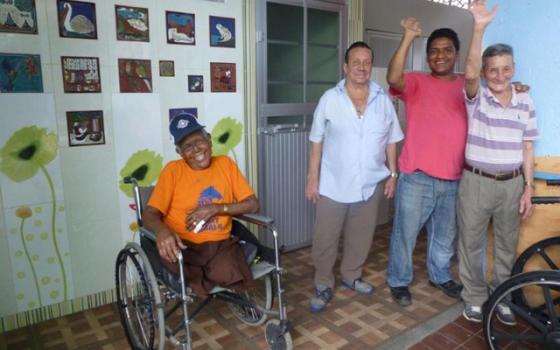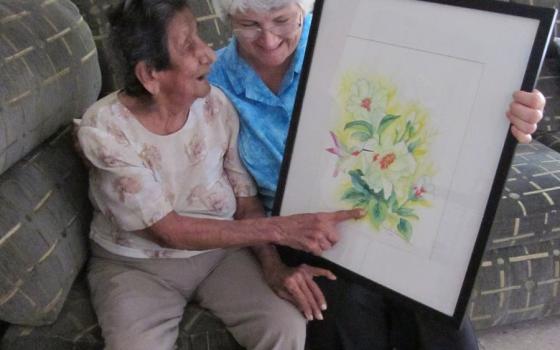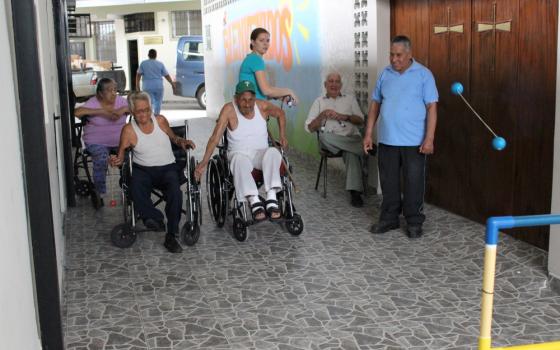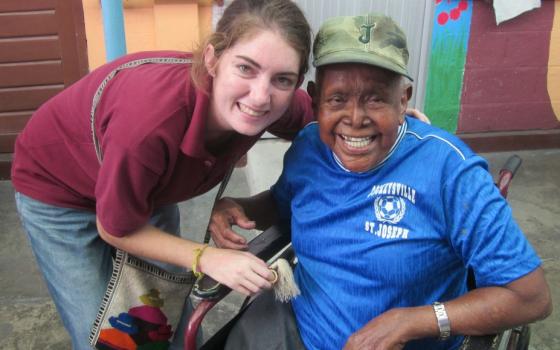"Sometimes, God calls us to do the impossible," Sr. Annie Credidio tells a group of high school students from the United States who are on a mission trip to Ecuador. "Sometimes, God calls us to do stuff that we are very uncomfortable doing. But if you 'let go and let God,' you kind of rise up above. You learn how to stay afloat."
This mindset has helped Credidio transform a neglected state-run hospital in Guayaquil into a model of care, love and dignity for patients with Hansen's disease (also called leprosy). Now known as Damien House (Fundación Padre Damian), this sanctuary symbolizes hope for the people with Hansen's disease and is celebrating close to 30 years of transforming the lives of its patients.
It all started back in 1988, when Credidio, a Brooklyn-born Sister of Charity of the Blessed Virgin Mary, was in Ecuador teaching at a preschool and wondering what God had in store for her.
She was invited to a Mass in the chapel of Ecuador's only hospital for infectious diseases.
"I'm sitting there in the chapel, and I'm waiting for Mass to begin," Credidio said. "I'm looking around and thinking to myself, 'Wow, these people are mutilated.' Some of them had bandages, some of them had no bandages. Some of them had this purple liquid all over them on top of their sores.
"I could see this woman from the corner of my eye who was being helped into the chapel. She was crawling on her hands and her knees, and so another woman went over and helped her up into the pew.
"When she sat there, I couldn't believe it: Her eyes were all cloudy, the cartilage on her nose was worn away — she just had a piece of flesh on her face," Credidio continued. "She had these long, elongated ears. She handed me this mitten hand — no fingers on either hand — and she said, 'Welcome!'"
The woman no longer had any teeth, Credidio said, but, "She had the most beautiful smile. Something went through me."
In that moment, Credidio knew she found her vocation. Since then, she has dedicated all of her energies to establishing and managing the nonprofit Fundación Padre Damian, named for St. Damien of Molokai, a patron saint of the sick.
From refuse to refuge: A home is born
At first, Credidio went to the hospital on weekends to teach art. Since Hansen's disease attacks the body's peripheral nerves, craftwork is an effective therapy to keep patients using their hands and fingers. As a preschool teacher, Credidio had a library of crafts to teach them.
She started with simple things, like bringing markers and explaining that they dry up unless the lid is snapped back on "until you hear the 'click.'" As she spent more time at the hospital with the residents, she noticed that the conditions there were substandard and inhumane.
There were often no nurses or doctors attending the Hansen's wing, and the ones who did were overworked. None of the windows had screens, and the sewers were without grates. At night, bugs would swarm the rooms while rats crawled up from the pipes.
"I remember waking up sometimes with a bloody bed where the rats had been biting me," said Pedro Calle, a current resident and former patient. "It hurt. The suffering that happened here was unlike anything you could imagine."
"Back when we started all this, the patients told me that there were cockroaches in their soup," Credidio said. "I didn't believe them at first, so they showed me. 'That's not a cockroach, it's a vegetable,' I told them. But then they lifted it up with their spoon, and I saw it was a cockroach. Can you imagine?"
When she went to the kitchen in the neighboring Hospital for Infectious Diseases the next day, she stood at the doorway in disbelief. As she looked around the rundown kitchen, which was missing ceiling panels above the stove, a rat ran across her foot.
She knew that simply doing crafts with these patients would not be enough. God had called her for a deeper purpose. However, she was still teaching her preschool classes at the time. So she asked volunteers from the newly formed foundation Rostro de Cristo ("The Face of Christ") to take over her classes.
At first, they were unsure about accepting the request, but upon seeing the state of the hospital and the energy that Credidio brought to the patients, RdC volunteers offered their support in the classroom.
In that first year alone, it was evident that her presence would be transformative. A paint company donated enough paint to lift the hospital's colors from a dreary gray to a brighter tone. Another company donated the materials to build screens for all of the windows.
The area in front of the hospital's broken gate had been a dumping site for garbage from the neighborhood. Piece by piece, the garbage was removed, and a big sign that read "No botar basura" ("Don't throw your trash here") was painted on the wall.
As improvements were made, Credidio and her cohorts took on increasing responsibility. As the quality of life improved for patients and residents, the operation costs grew.
Most of the hundreds of patients treated at Damien House stay just long enough to receive their medication then return home to their families. Those who need greater attention are invited to live there permanently.
Valentina Bravo has lived at Damien House since before Credidio's arrival. She said the hospital's transformation has changed everyone's lives.
"Look how pretty it is," Bravo said, pointing out the house's muraled walls, tiled kitchens and well-maintained gardens. "All of the decorations that you see — before, it was quite ugly. You can also see the changes in the men's bathrooms that are brand new. Now, you won't find any old beds, either. It is very different. People always say that we are privileged, and I say, 'Yes, because God has always had us in his sight. God has always had us in the palm of his hand.'"
Currently, there are close to 30 residents who receive care from the family of doctors, nurses and employees, who work 24 hours a day, seven days a week.
In 2015, Damien House separated from the Hospital for Infectious Diseases entirely. This meant increased fundraising efforts and higher bills, as Damien House no longer receives benefits from the state-run hospital. But as double-amputee Javier Garcia chortles from his wheelchair (provided free by Damien House), whatever they lose in benefits will be worth it to call the place their own home.
The patients aren't the only ones who have witnessed the hospital's evolution. The foundation's administrator, Germania Morán, has worked with Credidio for over 20 years and has seen Damien House's exponential growth.
"None of this was here when I started," she said, pointing around the clean and air-conditioned office from which she manages the more than $400,000 annual budget. "This whole building is new."
The building houses her office, their full-time physician's office, Credidio's office, a pharmacy, and the art room.
Earlier in the week, the art room was filled with a now-familiar sight at Damien House — a high school retreat group. Although many of the residents of Damien House have the non-healing ulcers that are trademarks of Hansen's disease, everyone living there has been cured of the bacteria that cause it. (There is no health risk to the hundreds of annual visitors.) In fact, if Hansen's disease is detected early, it can be cured with no symptoms or side effects. Even if it is diagnosed later, a multi-drug treatment can eliminate the disease.
For this reason, Damien House is able to invite visitors and volunteers to share their time and talents with the patients. In the past decades, scores of groups have come to be with the residents. Some groups help the hospital make physical improvements; some medical teams dedicate a week to cost-free surgery and therapy for patients; and some groups come simply to share in the ministry of presence with the residents, listening to their stories and offering them compassion.
According to Credidio, sharing talent or simply time is what it's all about. "Get to know the patients," she encourages everyone who visits.
"Hansen's has a stigma, and the stigma is what prevents people from taking a lot of their dear ones that you meet back into their homes," she tells the high school retreat group from the United States. "The patients have been cured, but they are no longer welcomed. They are the rejected and marginalized of society. So when you come . . . having visitors really makes a difference."
Every year, Damien House grows: It integrates new programs, invites new groups of volunteers, fixes and renovates the facilities, and more. With Credidio at the helm and all those who support their mission, this growth will continue to help bring love and dignity to the rejected members of society.
"When Mother Annie got here, it was like an angel fell right here on the patio to see our suffering and sadness," Calle said. "It's all been Sister Annie who has helped us — after God, it's her. Look at the work she's done!"
[Brian Bayer is a freelance writer and editor for V!va Travel Guides.]





